
 Nuclear-Powered Guided Missile Cruiser (CGN-35) 1967-1995.
Nuclear-Powered Guided Missile Cruiser (CGN-35) 1967-1995.US Cold War Cruisers:
Worcester | Des Moines | Juneau | Boston | Galveston | Providence | Albany class | Long Beach | Leahy | Belknap | Bainbridge | Truxtun | California | Virginia | Ticonderoga | Strike Cruiser (CSGN)USS Truxtun was a nuclear-powered single-ended guided-missile cruiser (all aft) as she was a stretched and modified Belknap-class, and third nuclear cruiser in the USN after Bainbridge and Long Beach, sporting with the same D2G reactors as the former. USS Truxtun was originally designated, like the Belknaps as a “destroyer leader” (DLGN), and re-rated after 1975 as a cruiser, final denomination CGN, but still, the smallest nuclear-powered warship ever in US service at just over 8,500 tons full load. She was commissioned in time to take part in the Vietnam war, making several tours of duty and earning there some seven battle stars. She also served extensively between the north and south pacific, indian ocean and took part in the post-Iran hostage crisis operations, Libya, Red Sea, and Gulf War, decommissioned in 1995. Her design’s lessons was put to good use for the next California class.
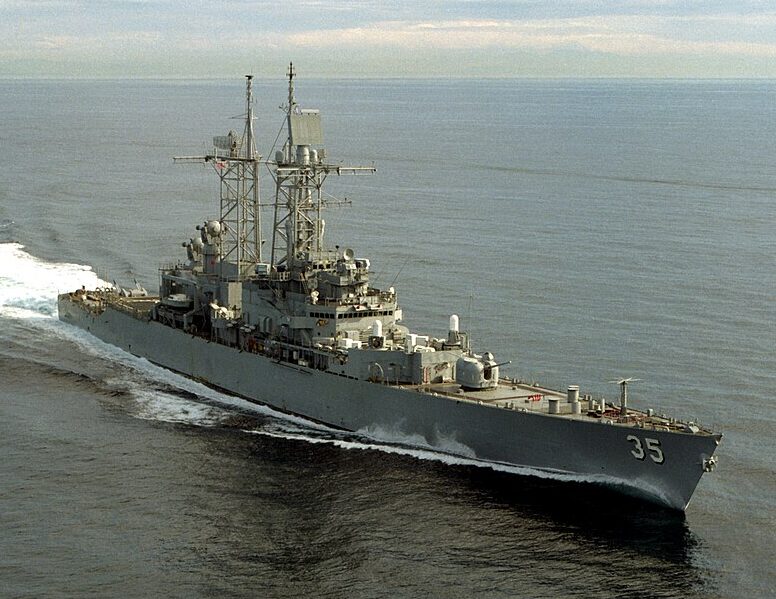
Design of the class
Development
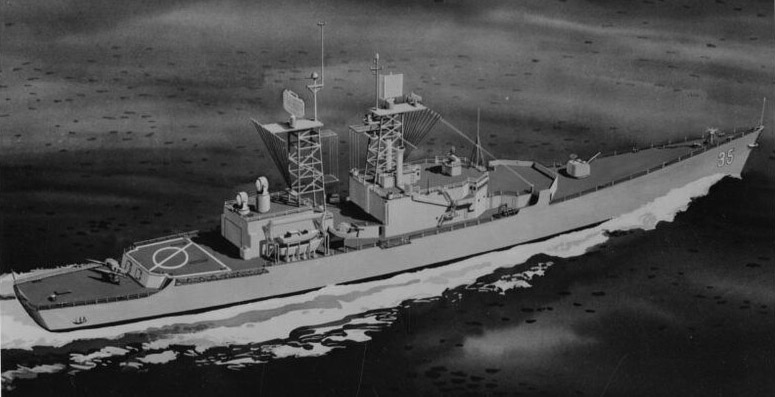
Artist view in 1966
USS Truxtun was motivated by the rejection of the USS Long Beach design, massive and costly ($332.85 million versus a Coontz class DLG/DDG was $52 million), for a future nuclear-powered “frigate”, and if the Navy seriously considered ordering a “repeat Bainbridge” they also considered the improvements of the Belknap notably with the SQS-26 bow sonar were too important to miss, and the design team tried to rearranging and modify the Bainbridge hull to fit the larger sonar electronics forward, displaced the Mk 10 aft and fit a third ammo ring deep in the hull so the sonar was more forward than usual. For the rest she was made virtually identical to a regular Belknap class cruiser in general appearance and weapons systems, although a whole section of 17 feet (5.2 m) was added mid-ship for her two D2G reactors, replacing the regular four 1,200 psi boilers. But her hull was broaden as well of 3 feet (0.91 m) and she was havier in displacement, 2-ft deeper (0.61 m) for her draft, 1,200 more tons in displacement.
The Truxtun design was generally considered a success, she was commissioned and the results of early trials and tests the Navy was more in the attitude of building a new class, instead of just retaking and improving the Truxtun. In 1968 was authorized a third California, cancelled and reworked to later give birth to the Virginia class, weheras techology was advancing greatly in many areas. Admiral Rickover also pushed for four nuclear escorts in each nuclear carrier battle group (ie USS Enteprise and the Nimitz class), and that cold only be achieved with the 1974 commissioning of California for the “big E” battle group, but this was gone with the commissioning of Nimitz in 1975. Rickover in the end couldn’t convince the Congress to fund that many new nuclear cruisers. By the way after the fourth Virginia class was commissioned 18 October 1980, the new order of the say was to procure each battlegroup conventionally-powered, cheap Ticonderoga class “cruisers”.
Hull and general design

Conway’s profile of USS Truxtun.
Overall, she displaced 8,659 tons fully loaded (versus 7,930 tons) for an overall lenght of 564 ft (172 m) (versus 547 ft), for a beam of 58 ft (18 m) versus 55 ft/17 m, and a draft of 30 ft 6 in (9.30 m) versus 29 ft/8.8 m.
As for the superstructures she ended quite different as the Belknap class still. She kept her two island configuration, with mosy of the aft one taken by the heli-hangar and helicopter deck above the aft standard/AROC launcher located on the lower deck. Having no macks (combined funnels/masts) her sensors were located on two large and tall derrick masts. Services boats were located under two davits alonsgside the aft structure. The two fore control radars were stagerred on the roof of it. There were also two 76 mm (3-in/50) AA batteries amidship, between islands.
She had 492 officers and ratings but often worked as flagship in later years, and to her crew rose to 510 with her Flag accommodation for 6 officers and 12 assistants.
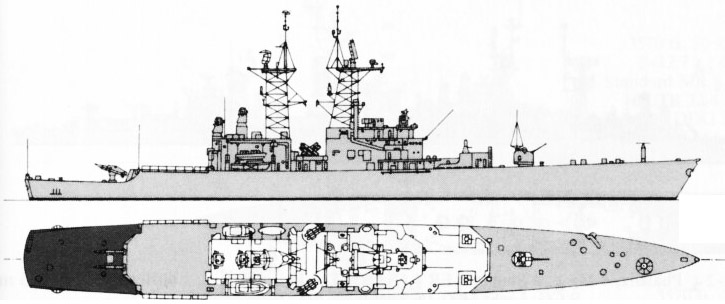
The space forward of the bridge is occupied by the forward reactor and the NTDS computer room is probably not in the deckhouse above, forwards of the reactor refueling hatch. Weight distribution was an issue due to the lack of volume, with tight weight margins for two Mk 14s and SPG-59 radar.
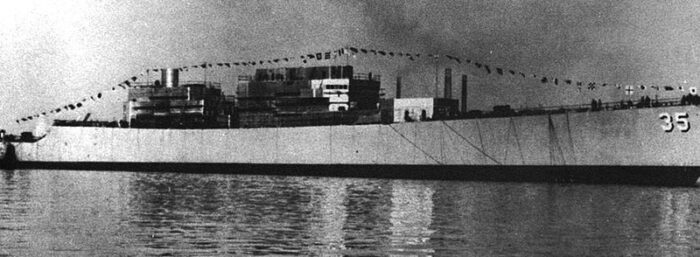
Launch at Ny shipbuilding Corps, Camde, NJ, 19 December 1964.
Lessons learned on the Truxtun class were later adopted to the next California and Virginia classes, last USN nuclear-powered cruisers.
Powerplant
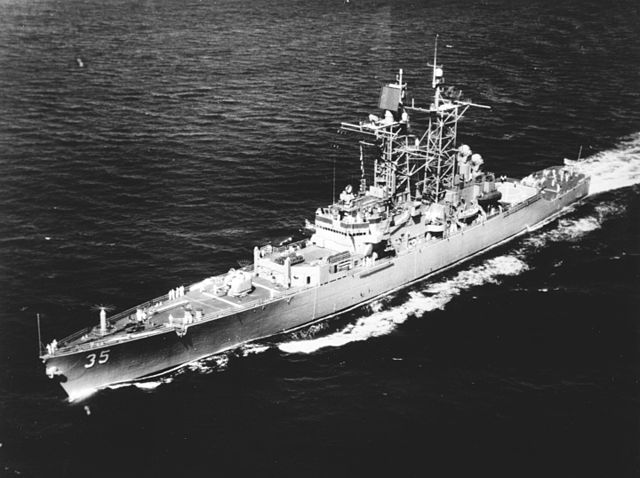
USS Truxtun underway in 1967
The biggest change of the design, and most was a repeat of the previous USS Bainbridge on the Belknap hull, which was pretty close. The powerplant comprised two GE pressurized-water D2G nuclear reactors, driving two steam turbines, two shafts and propellers for a nominal total of 70,000 shp (versus 85,000 shp (63,384 kW) on the Belknaps). However the reat output and top speed (31 knots could be superior (and classified). Range of course, was unlimited.
Armament
Truxtun was commissioned with the following at first:
-5-inch/54 Mark 42 gun, foredeck
-RIM-2 Terrier, twin-arm Mk.10 launcher quarterdeck aft, 40 missiles
-RUR-5 ASROC, same launcher, 20 missiles
-2x 3-in/50 Mark 33 AA, amidships
-2×2 12.75″ Mark 32 fixed ASW torpedo tubes, poop
Main: Missiles. RIM-2 Terrier
The Terrier missile was standard since the Leahy class and earlier conversions. The Terrier system was later upgraded to launch the compatible RIM-67A Standard missile. The unchanged missile depot was placed under the helicopter deck with a converyor belt and capacity for forty RIM-2 and later RIM-67 Standard, plus 20 RUR-5 ASROC missiles. Indeed the original Mark 10 launcher was already “universal”, capable of launching the ASROC.
⚙ RIM-2 Terrier |
|
| Launcher | Twin-arm, 280° traverse and 60° elevation |
| Weight | 1,180 lb (540 kg), booster 1,820 lb (830 kg), total 3,000 lb (1,400 kg) |
| Size | 27 ft (8.2 m) x 13.5 in (34 cm) |
| Warhead | 218 lb (99 kg) frag/1kT W45 nuclear |
| Engine | Solid propellant rocket motor |
| Speed | Mach 3 |
| Range | 17.3 nmi (32.0 km) |
| Ceiling | 80,000 ft (24,000 m) |
| Guidance | Beam-riding |
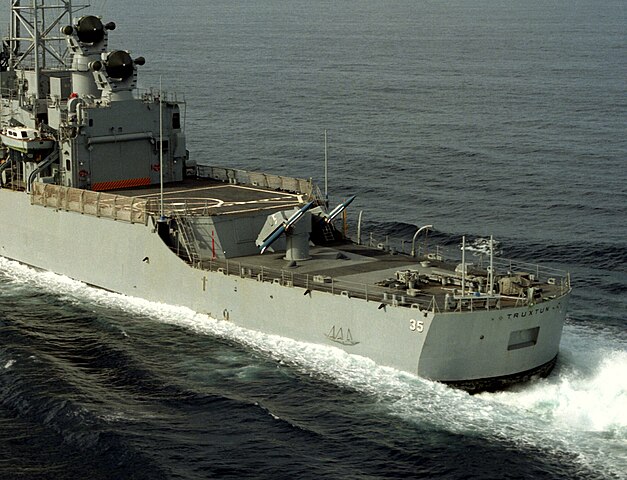
Mark 10 launcher aft, 3 January 1989
ASW Missiles: RUR-5 ASROC
Launched from the same Mark 10 twin arm launcher aft. Provison for twenty missiles, located in a different storage room at the end of the conveyor belt. Note that there were three 20-missile horizontal drums in magazine, two for the SAM, one of the ASROC.
⚙ RUR-5A Missile |
|
| Container | Full traverse/elevation 8-canister box launcher |
| Weight/size | 1,073 pounds (487 kg), 14.75 ft (4.50 m) x 16.6 inches (420 mm), wspan 26+7⁄8 inches (680 mm) |
| Warhead | Mark 46 Torpedo, HE or 10 kt (42 TJ) W44 nuclear |
| Engine | Solid propellant rocket motor |
| Speed | Subsonic |
| Range | 6 mi (9.7 km) |
| Guidance | Vectoring, beam-riding |
Main gun: 5-inch/54 Mark 42
This guns constitutes a novelty compared to the Leahy class, which were “pure” missile cruisers, and a benefit from the Mark 10 univeral launcher, mixing ASROC-Terrier. The space available enabled the installation of the universal 5-Inch/54 Mark 42 gun, 127 mm, enabling dual purpose fire on air targets in the inner bubble (past the SAM range), surface warfare and anti-missile awarfare to some extent (after later upgrades) as well as shore bombardment, which explains why the Belnkaps were much more active in Vietnam than the Leahy.The 5″/54 caliber Mark 42 gun designation indicates that the gun has a bore diameter of 5 inches, and the barrel length is 54 times the bore diameter. In this case, the barrel is 270 inches (5 x 54). It is fully automatic, dual-purpose, with high rate of fire. It is capable of sustained rates of around 40 rounds per minute. It is designed to fire various types of ammunition, including high-explosive rounds for surface targets and proximity-fused rounds for anti-aircraft engagements.
The gun turret existed in single mounts or dual mounts here, single, with an effective range varies depending on the type of ammunition used and the target.
⚙ 5-Inch/54 Mark 42 gun |
|
| Turret size | 9.652 m (31 ft 8.0 in) |
| Turret Weight | 60.4 long tons (61.4 t) |
| Barrel | 6.858 m (270.0 in, rifling 5.82 m (229 in) |
| Recoil | 18.75 inches (476.2 mm) |
| Elevation/Traverse | -15°/+85°, rate 25°/sec – 150° from either side centerline, rate 40°/sec |
| Shell | 127 x 835mm .R 31.75 kg (70.0 lb) |
| Muzzle velocity | 2,650 ft/s (807.7 m/s) |
| Rate of fire | 40 rpm automatic original down to 28 rpm 1968 |
| Range (surface) | 25,909 yd (23,691.2 m) at +45° elevation |
| Ceiling (AA) | 51,600 ft (15,727.7 m) at +85° elevation |
| Guidance | Mark 68 gun fire control system with AN/SPG-53 radar |
AA: 2×3-inch/50 AA
Since the alledged remark of President Kennedy, since USS Long Beach, all missile cruisers were given two 3-in/50 AA guns as a “guarantee” of response of the main surface to air missile system failed to stop an incoming threat.
⚙ 3-in/50 Mark 33 specifications |
|
| Shell | 12.13 in (30.8 cm) 24 lbs. (10.9 kg) |
| Elevation/Traverse | -15°/+85° at 30°/sec and 360° at 24°/sec |
| Muzzle Velocity | 2,700 fps (823 mps) |
| Antiship Range | (45°): 14,600 yards (13,350 m) |
| Rate of Fire | 40 rpm automatic (28 in 1968) |
| Ceiling | (85°): 30,400 feet (9,266 m) |
| Crew | 9 |
ASW: 2×2 323 mm (12.75 inches) Mark 32 torpedo tubes
Two of two, fixed, firing at the poop.
⚙ Mark 46 mod 0 acoustic torpedo |
|
| Powerplant | 2-speed, reciprocating external combustion (Otto fuel II) |
| Weight and size | 508 lb (230 kg), 8 ft 6 in (2.59 m) x 12.75 in (324 mm) |
| Warhead | PBXN-103 HE HBX-3 96.8 lb (43.9 kg) |
| Speed | 40 kn (74 km/h; 46 mph) |
| Range | 12,000 yd (11,000 m) |
| Exploder | Mk 19 type Mod 12 contact exploder |
| Guidance | Active/passive, homing (Helix/snake search) 123m to 3.4 miles (5.5 km) |
| Max depth | 1,200 ft (370 m)) |
Protection
STS (later possibly kevlar) paneling around the Central Operation, over the missile carousels and above the steering system, perhaps 1.1 inches, not precised, some sources even states nothing at all. Classified information. That would be nice to be updated on this.
Sensors
AN/SPS-10 surface search RADAR:
Old Raytheon 2D, 280 kW radar (1959) FRQ C Band, PRF 650 Hz bmt 1.9° × 16° pwt 1.3 µs
AN/SPS-40 air search RADAR:
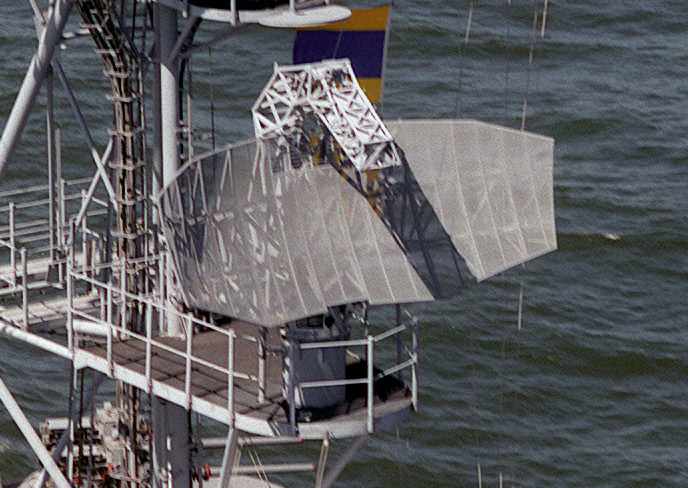
1961, 2D 140″x214″ Air-search Radar: FRQ 400-450 MHz, UHF band, RPM 7.5-15 rpm, Range 250 nmi. 360°, 19°/10.5° PW 200-300 kW
AN/SPS-48 3D air search RADAR:
1966 17 ft 35 Kw 3D Frq E/F band Range 250 nmi (460 km) alt 100,000 ft (30,000 m)
2x AN/SPG-55 Terrier fire control RADARS:
3D data, C-band (Tracking) or X-band (Illuminator) PRF 427 Hz, Range 300,000 yd (150 nmi)
AN/SQS-26BX SONAR:
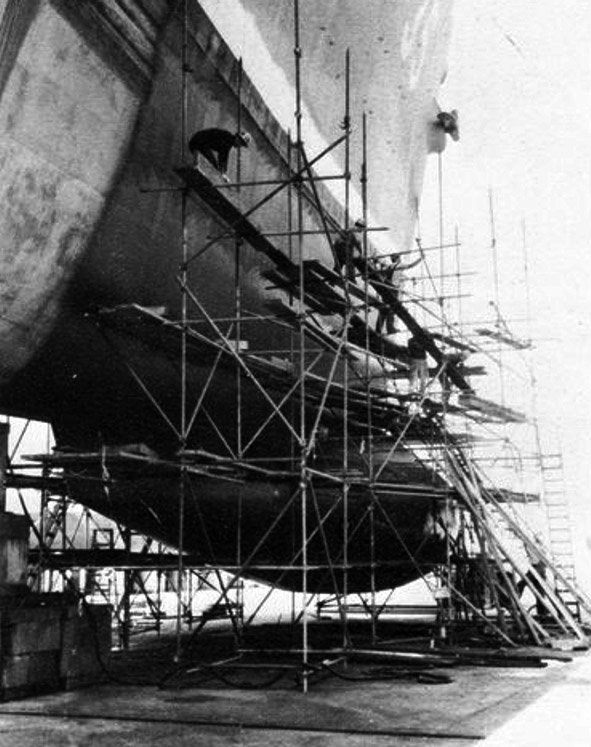
27,215 kg (59,999 lb) operating as passive sonar (FRQ 1.5 kHz) or active at 3–4 kHz. Max output 240 kW, range 18-64 km (11-40 mi), direct path, bottom reflected, passive and convergence zone (CZ) capabilities. Manufacturer: General Electric Heavy Military Electronic. Replaced by the CX variant capable of 360° long-range sector search at low frequency and later by the AN/SQS-53 A/B/C with digital computer interface.
Other sources precised she was also equipped with the SPG-53 and two Mk 35 radars (for the 3-in/50 AA).
WLR-1 ECM suite:
Shipborne radar warning receiver (RWR), early 1960s. Capable of real-time intercept of signals, direction-finding, processing evaluation of radio-frequency signal emitters (0.5-18 GHz bands).
see also
Two Mk 28 decoy RL:
The Mark 28 Mod 0 target flar uses a radiometer (2μm to 6μm bandpass) to acquire spectral information for the flare NOTS Model 711A and NOTS Model 712A target augmentation flare.
NTDS CCS:
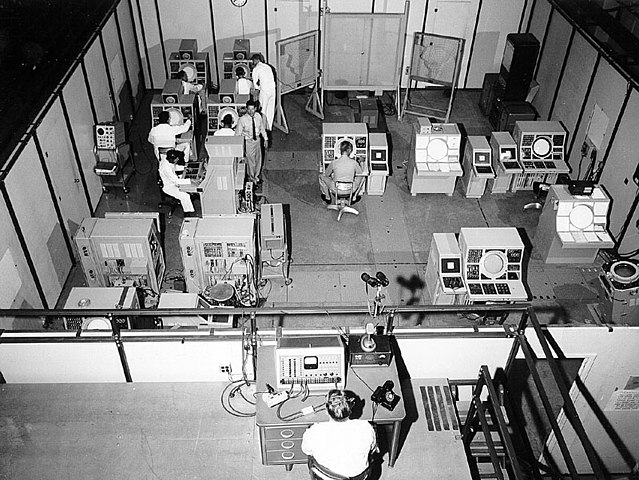
Naval Tactical Data System, buried deep into the ship and probably armoured. Combat Information Center (CICs) collect, sort and communicate all battlefield information known for decision making.
Used various brands of USQ types Univac computers, in tht case probably the AN/UYK-8, embedded, as well as a RISC-like instruction set, water-cooled, and from 1972, air-cooled. It was developed for use with the AN/TYA-20. Work with the Beach Relay Link-11 communication system. No more details specific to USS Truxtrun.
Air Group
DASH
The Gyrodyne QH-50C DASH was an unmanned anti-submarine helicopter, remotelly controlled able to operate two Mark 44 homing ASW torpedoes over 22 nmi (41 km; 25 mi) around the ship. But it was completely unreliable with 50% of 746 drones lost at sea. Much had been said on these early drones, which had an appealing record of losses, accidents or malfunctions. This was 1960s technology after all. In the 1970s, most of the ships got rid of their Drone.
⚙ Gyrodyne QH-50C |
|
| Size | 12 ft 11 in (3.94 m) x 9 ft 8.5 in (2.96 m), rotor 2× 20 ft 0 in (6.10 m) |
| Weight | 1,154 lb (523 kg) max TO 2,285 lb (1,036 kg) |
| Powerplant | Boeing T50-BO-8A turboshaft, 300 shp (220 kW) |
| Speed | 80 kn (92 mph, 148 km/h), cruise 43 kn (50 mph, 80 km/h) |
| Ceiling | 16,400 ft (5,000 m), 1,880 ft/min (9.6 m/s) |
| Range | 35 US gal (29 imp gal; 130 L), 1h, 71 nmi (82 mi, 132 km) |
| Payload | 2x Standard Mark 46 ASW homing torpedoes or single Mark 44. |
| Guidance | Remote, from ship operator by multi-channel analog FM |
SH-2F LAMPS-I/II

The Kaman SH-2 Seasprite was for decades the main ASW and SAR helicopter onboard most ships of the USN. The prototype first flew in 1959, and it was adopted from 1966, the SH-2D/F LAMPS I version being the first deployed from december 1971. Later the 2F was developed. Full post on Plane Enyclopedia.
Upgrades
Truxtun initially replaced its 3-inch/50 cal. in 1979 by two quad Harpoon missile launchers, same location. The ASW suite comprised at first the un-manned DASH, in 1971 the hangar was upgraded and enlarged in order to operate the LAMPS Mk.I with the SH-2 Seasprite helicopter. If USS Truxtun was not upgraded under the NTU program, she still received two Phalanx CIWS systems installed forward on the structure close to the launcher. New electronics were also installed during her last overhaul and nuclear refuelling.
Chronology:
In the 1970s her torpedo tubes and DASH drone helicopter are removed, the later replaced by a single SH-2D Sea Sprite.
In 1980 her Terrier SAM/ASROC ASuR is replaced by the Standard SM-1MR SAM/ASROC ASuR 76/50 (also with 60 missiles, same system).
Two quad Harpoon RGM-84A replaced the single 3-in/50 mounts.
The whole eltronic suite is gutted: The SPS-10, SPS-40, SPS-48, 2x SPG-55, and the two Mk 35 radars are removed and replaced by the LN-66, SPS-48C, SPS-40D, and two SPG-55B fire control radars
In April 1984 her SPS-10, SPS-40, and SPG-53 radars are also removed as well as her WLR-3 ECM suite and her two Mk 28 decoy Rocket Launchers, replaced by the SPS-40D, SPS-48C, SPS-67, SPG-53F, and Mk 90 fire control radars for the Standard SAM as well as the new SLQ-32(v)3 ECM suite and four Mk 36 SRBOC decoy RL. Still less developed than NTU upgtrade, it was still pretty close and added at least six years of useful service.
As for the armament in 1984 she also receives two six-tubes Gatling type 20mm/76 Mk 15 Phalanx, and four single 12.7mm/90 (Browning M2HB 0.5 in), to deal with asymetric threats.
In 1990 her electronic suite was renovated again with the replacement of the LN-66, SPS-40D, SPS-67, and her two SPG-55B radars for the SPS-49, SPS-64(v)9, SPS-67(v)1, and two SPG-55C radars, and she also received the Mk 6 Fanfare torpedo decoy system. This only was for prolongating her useful service for five years. Her powerplant showed signs of weakness after 25 years of continuous service.
⚙ specifications |
|
| Displacement | 8,659 tons FL |
| Dimensions | 564 x 58 x 30 ft 6 in (172 x 18 x 9.30 m) |
| Propulsion | 2 shafts GE pressurized-water D2G nuclear reactors 70,000 shp |
| Speed | 31 kt |
| Range | Unlimited |
| Armament | 2×5-in/54 DP Mk 42 gun, 2×2 Mk 10 Mod 8 Standard/ASROC, 2×2 Mk 32 ASWTTs, 2×4 Harpoon, 2× Phalanx CIWS |
| Protection | Kevlar C3R, Ammo |
| Sensors | AN/SPS-10 SSR, AN/SPS-40 ASR, AN/SPS-48 3D ASR, 2x AN/SPG-55 Terrier FCR, AN/SQS-26 sonar |
| Air Group | Facilities for 1 SH-2F LAMPS-II |
| Crew | 492 officers and ratings, Flagship +6 officers, 12 enlisted. |
USS Truxtun’s career
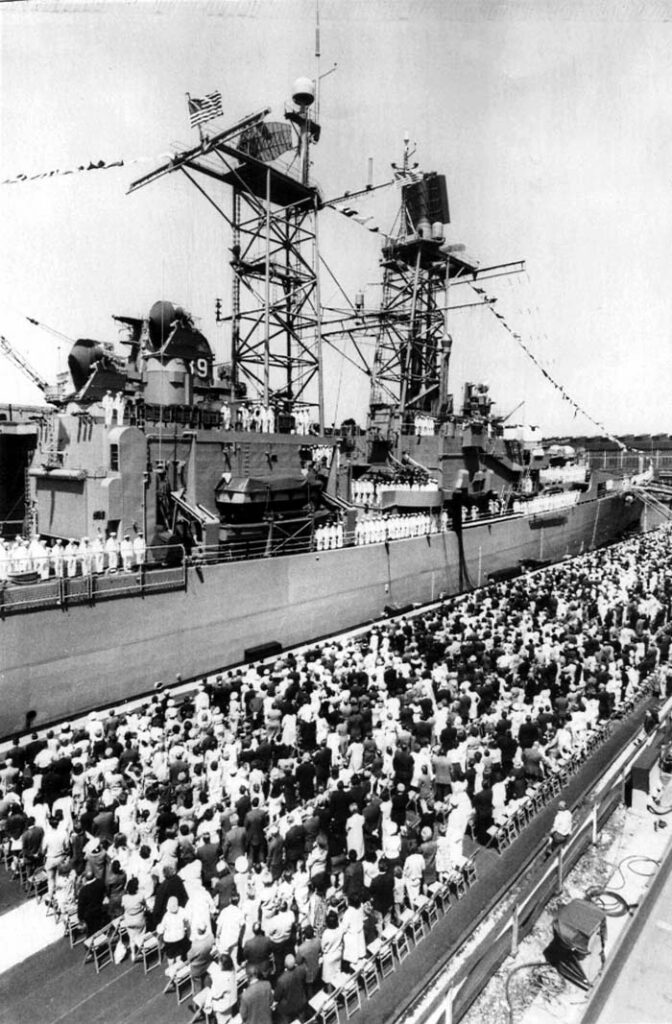
Commissioning ceremony (navsource)
USS Truxtun was launched at New York Shipbuilding Corp. Camden, New Jersey on 19 December 1964, commissioned on 27 May 1967. On 3 June 1967 after sea trials, she headed for the West Coast via Yorktown and Norfolk and started a long cruise in the Guantánamo Bay (Cuba), and went on southwards to Rio de Janeiro, Mar del Plata, rounded Cape Horn (10 July) to joing her assignation in the Pacific, stopping at Valparaíso, Mazatlán, and arriving at Long Beach, her new home port (29 July). After supplementary navy trials by the late summer she started her shakedown training at last in November, interrupted on 10-11 November for Exercize “Bell Anchor” and 27 November-3 December for “Blue Lotus.”
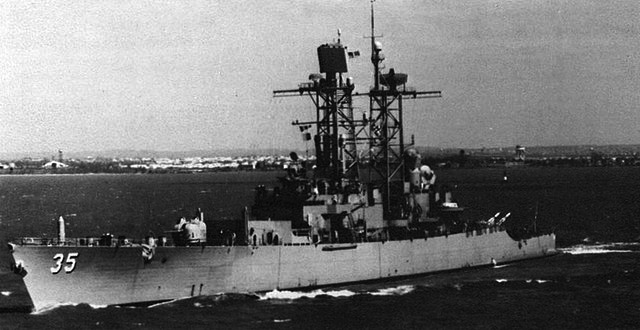
Freshly completed Truxtun on the Delaware River, 3 June 1967
Vietnam Campaign
On 2 January 1968 after post-fixes at Long Beach and preparations, she departed for her first WestPac tour. After a night stop at Pearl Harbor (7/8 January) she arrived in Sasebo by 19 January and joined USS Enterprise, leaving Sasebo for the Sea of Japan after the “Pueblo crisis” (North Korea’s capture of a covert intel vessel, Pueblo).
She left the Sea of Japan on 16 February for the coast of Vietnam via Subic Bay (19–20 February) and she took her post at “Yankee Station”, Gulf of Tonkin. She alternated her plane guard tasked for Enteprise, Bon Homme Richard and Ticonderoga, surveillance duties with search and rescue (SAR) missions.
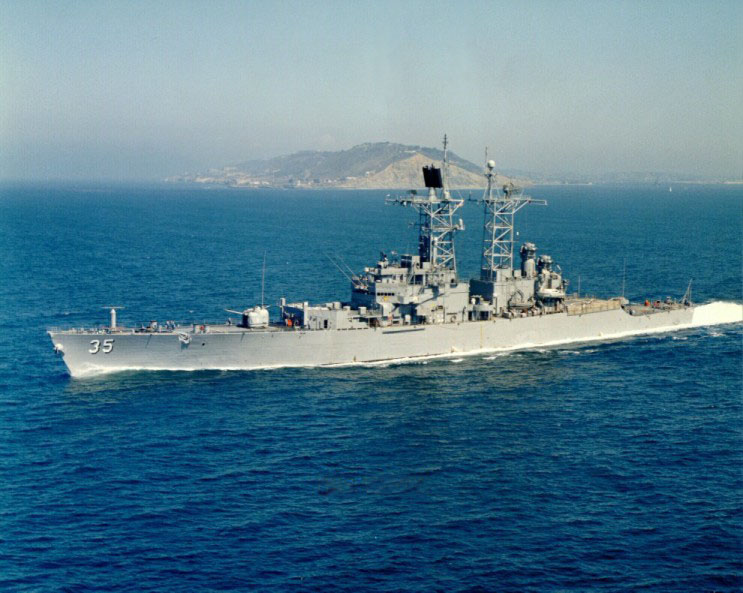
Off Point Loma, Calif.
She vectored aerial traffic and watched for North Vietnamese air intrusions as part of the usual Positive Identification Radar Zone (PIRAZ) picket ship duties for missile cruisers. She left the area for short periods of R&R and resupply at Singapore, Hong Kong, Danang, and Subic Bay. On 6 July, she left the Philippines for home, con,cluding her first TOD, entering Long Beach on 19 July for a short maintenance overhaul.
The next months of 1969 saw her training off the West Coast, and acting as plane guard for USS Ranger, Kitty Hawk, Enterprise and Yorktown during their own landing qualifications. By mid-November, she became ASW school ship, hosting student sailors. By December, she returned to Long Beach for overhaul preparations, shifting by January 1969 to Bremerton, Puget Sound until April 1970. She returned to the West Coast until 23 September and was prepared for her second TOD with the 7th Fleet, stopping at Pearl Harbor, and ending at Subic Bay, 20 October 1969. She later trained at Okinawa.
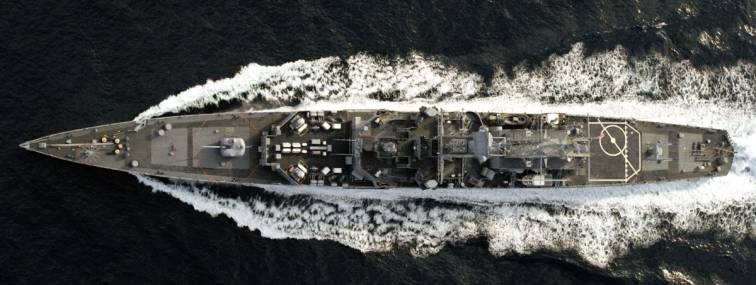
Overview (navsource)
This was a repeat of the 1969 missions, with some stops at Hong Kong, Singapore, and Subic Bay and in addition to plane guard/PIRAZ/SAR duties, she took the role of peacetime aerial reconnaissance protective (PAPRO) picket, in the Sea of Japan and took part in the Taiwan Strait patrol. After a stop at Sasebo, 6-11 March 1970, earning a Navy Unit Commendation, she was back to Long Beach on 23 March. Navy inspectionscommenced, after which she made training cruises. By June she carried 40 NROTC midshipmen (summer cruise), firing life missiles at the Pacific range, visiting San Francisco and Seattle and by 13 July, sailed for Pearl Harbor, then back HP on 29 July, to disembark midshipmen, and resumed her usual training until late October, and then a 3 months restricted availability at Long Beach Naval Shipyard from 2 November.
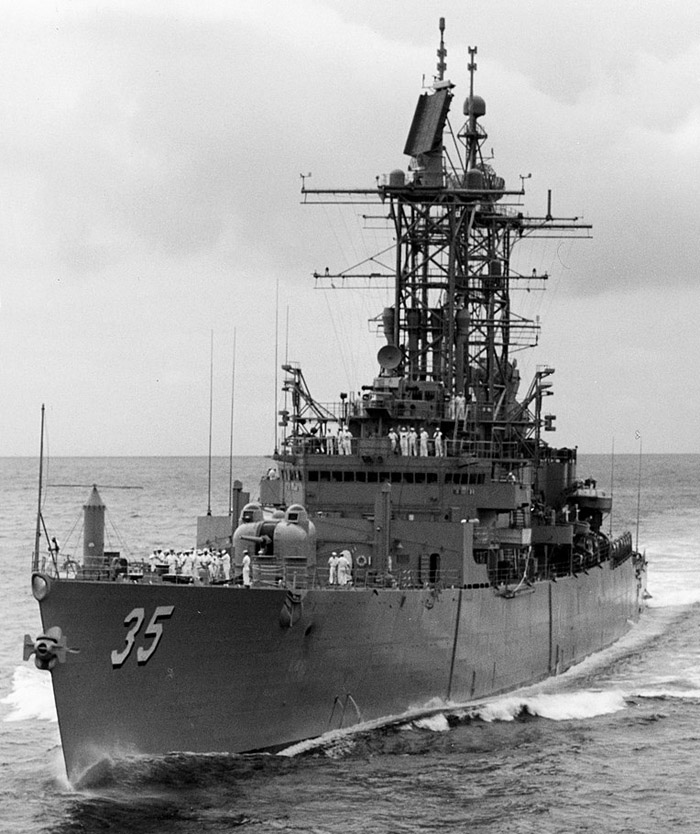
Underway 3 off Hawaii, july 1970
Yard work was completed in mid-January and after ASW training she started her third WestPac deployment after preparations at Long Beach on 22 January-2 February 1971. She stayed two days at Pearl Harbor and resumed her trip on 9 February to Subic Bay, the 20th and resuming her duties on Yankee Station, visiting also Yokosuka, Japan, with R&R at Hong Kong and Sattahip in Thailand. In April she also took part in the Taiwan Strait patrol.
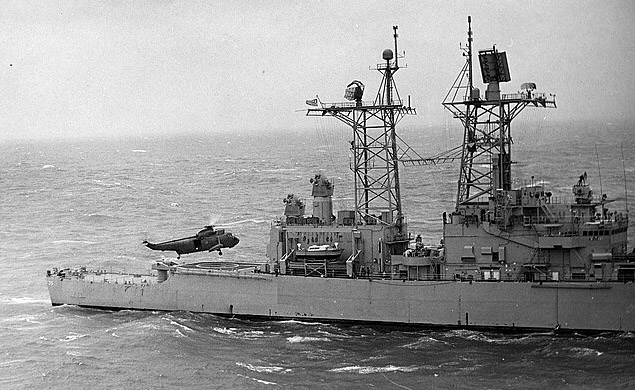
HH-3A HC-7 landing off Vietnam, 1970
On 6 July, she left the Gulf of Tonkin, stopped at Subic Bay, then sailed for Fremantle, Australia for a week R&R, and while back home, stopped at Pago Pago in Samoa, then Pearl Harbor, and was at homeport on 17 August. In September drills resumed, notably with missile and artillery. She had the visit of a Board of Inspection and Survey and based on recommendation, was placed on restricted availability and modified to deply the Light Airborne Multi-purpose System (LAMPS) helicopter. 18 November-December saw her in post-availability dock trials, training, tests with the LAMPS system. On 14 December 1971 Naval Air Systems Command certified her installation sto she can resume operations.
During the first six months of 1972, Truxtun operated out of her home port in North American coastal waters. She conducted exercises, entertained visitors, and underwent several inspections. Following another restricted availability in June, she spent July preparing for her fourth tour of duty with the U.S. Seventh Fleet.[citation needed]
On 13 July, she departed Long Beach with HMNZS Canterbury for a fourth deployment off Vietnam. She was at Subic Bay on 4 August, loaded ammunition and reached the Gulf of Tonkin for a five months SAR/PIRAZ picket duty, also evading three typhoons. On 8-15 October she directed fighter interceptions leading to six MiG kills and later 11 North Vietnamese MiGs, 3 rescues for a second Navy Unit Commendation being awarded.
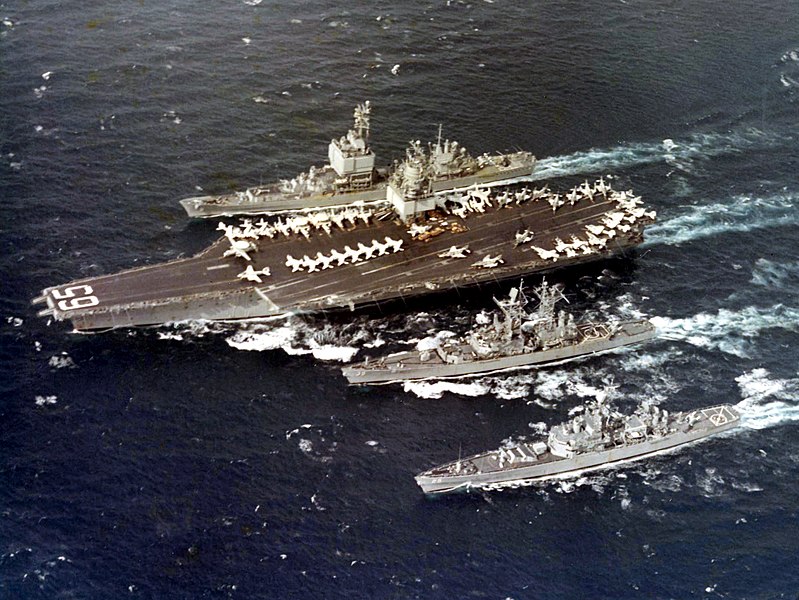
With USS Enteprise Battle Group and Long Beach, Gulf of Tonkin 1972
From October to January she took part in the Taiwan Strait patrol and by 21 January 1973 was rellieved by USS Reeves on her north SAR station, after a stop at Yokosuka (26-30 January), she sailed to Pearl Harbor and Long Beach. On 19 March, she was in tender availability alongside USS Piedmont until late April and resumed local operations. By May, she after various qualifications at San Clemente Island she started in June her NROTC midshipmen summer cruise, until 27 July. She started her fifth WestPac on 17 August, via Pearl Harbor to Subic Bay (5 September) and as tensions were now practically over, she started a quiet PIRAZ station in the Gulf of Tonkin cut by missile exercises and ASW drills. After a stop at Subic Bay she departed in December for home and by Xmas 1973 was prepared for her first complex overhaul.
Post-Vietnam Service
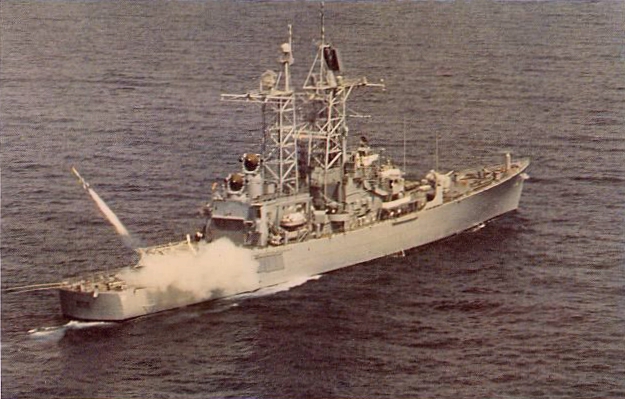
Truxtun launches a missile in 1976
On 25 January 1974, she left for Bremerton, Puget Sound providing her drydock 18-month overhaul. She had her reactors refueled and by 30 June 1975 was reclassified as cruiser (CGN-35. By 31 July, she started her trials and headed for San Diego (4 August) to resume local operations for 12 months.
On 30 July 1976, she left San Diego, for a 6th western Pacific tour, after training in Hawaiian Islands, she made a detour to Wellington and Melbourne before reaching Subic Bay on 25 September. She left Subic Bay on 28 October after local drills, and ventured in the Indian Ocean a for Operation “Midlink 76.” She stopped at Karachi in Pakistan, 9 November for exercises briefings and joined it on 13-21 November off the coast of Pakistan. She was soon back at Subic Bay for local operations and a rtripto Hog Kong on 4-13 January 1977, then READEX 1–77 (15-21 January) and back to the Indian Ocean with USS Enterprise and Long Beach, exercise “Merlion III” with the Singapore Armed Forces (25 January), Operation “Houdini” in February and stoping in Seychelle Islands, then back to Subic Bay on 13 March and sailing for home.
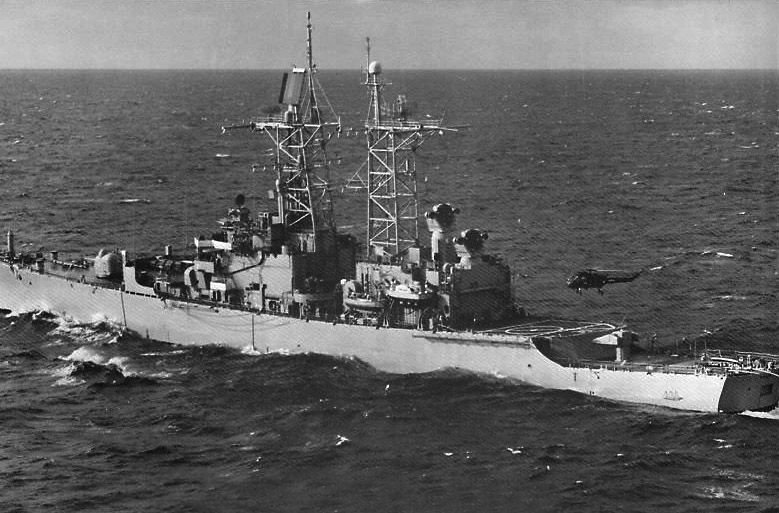
Westland Wasp landing, 1976
In San Diego she started on 28 March a 4-week restricted availability, and local operations for six months, then spent November at Puget Sound for an overhaul to her nuclear power plant, then back to local operations until the fall of 1977. In 1978 she was prepared for her 7th western Pacific TOD, leaving her HP on 4 April for six months with the 7th Fleet, notably in the Arabian Sea and also made a tour in Australia. She also visited en route Colombo, Hong Kong, Pusan, and was back to San Diego on 27 October. In 1979 she departed San Diego and left for Bremerton for another overhaul in a floating drydock.
Middle East/Pacific 1980s Service
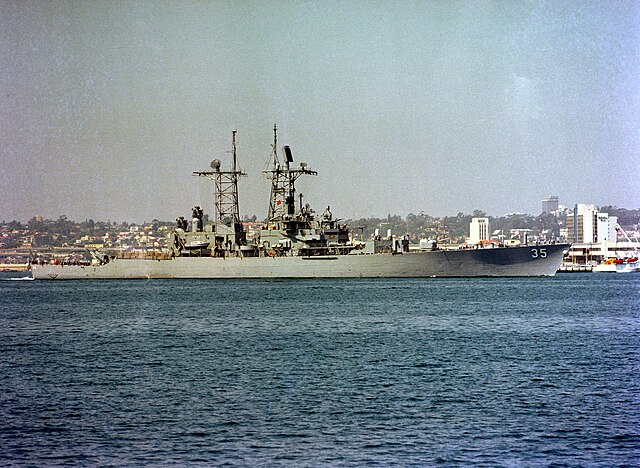
In San Diego Bay 27 july 1984
On 26 February 1980, she left San Diego for her 8th WESTPAC, in the USS Constellation Battle Group under Capt. E.M. Baldwin, in command, taking part in RIMPAC 1980 (March) and after as top at Pearl Harbor, reached Subic Bay for brief maintenance and arrived in the Indian Ocean, taking part in the Iranian Hostage Crisis standown. On her way back she stopped at Pattaya Beach and Wellington (there her deployment was disturbed by Anti-nuclear protests), and by 15 October 1980, left Subic Bay for San Diego.
On 20 October 1981, she started her 9th WESTPAC via Pearl Harbor, Subic Bay reaching the Indian Ocean and trained in the South Pacific. She stopped in Mombasa, Perth, Diego Garcia, Brisbane, Hobart, Nuku’Alofa (Tonga), Wellington, and by 12 June 1982, wa sback to San Diego; prepared for her Complex Overhaul at the Washington Puget Sound Yard from September 1982 to July 1984, having notably her whole combat system suite upgraded.
On 15 January 1986 she started her 10th WESTPAC, as Anti-Air Warfare Commander (AAWC) for the Battle Group FOXTROT and by April, transiting westwards via Panama and Gibraltar, she was deployed off Libya in the Gulf of Sidra, with USS Enterprise and USS Arkansas. After two months they existed Gibraltar for the Cape of Good Hope, and from there, reached Western Australia, the Philippines and training for over 65,000 miles, commemorating the 25th anniversary of Operation Sea Orbit (first nuclear-powered fleet cruise)
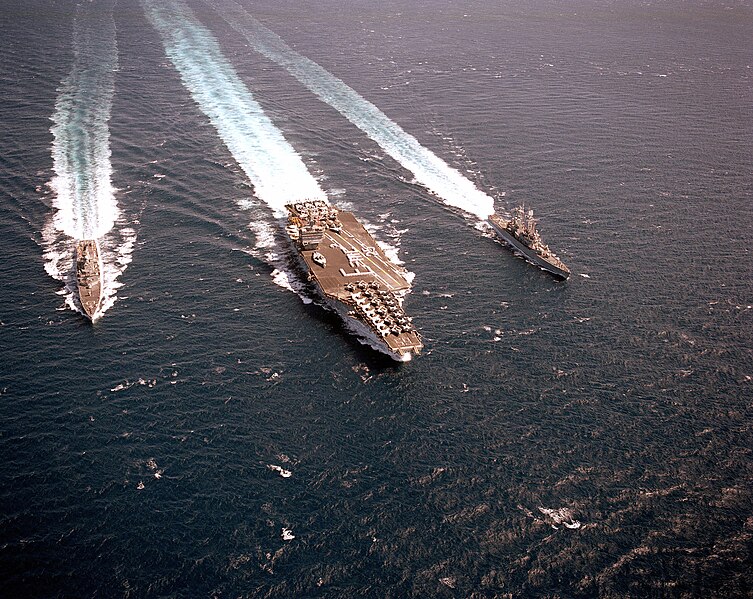
With Battle Group FOXTROT, 1986, alongside USS Arkansas, Pacific 17 sept. 1986
On 26 October 1987, Truxtun made another deployment with the Battle Group FOXTROT, and first Northern Pacific, the largest Surface Action Group exercises, directed at the Kamchatka-Aleutians region. She returned with Battle Group FOXTROT on 5 January 1988 (11th WestPack-Middle East deployment), taking part in Operation Praying Mantis, earnign the Expeditionary Medal and and Meritorious Unit Commendation. Back home she spent 9 months in Puget Sound for selective Restricted Availability. By 1 October 1989 she learned her homeport was now Bremerton in Washington.
Gulf War and late service
On 1 February 1990, USS Truxtun made her 12th deployment in USS Carl Vinson “Battle Group Charlie”, taking part in TEAM SPIRIT 1990 with the Republic of Korea. Next she sailed for the Indian Ocean and North Arabian Sea, taking part in Operation Earnest Will, escorting re-flagged Kuwaiti oil tankers in the Straits of Hormuz and Persian Gulf (and earning a second Armed Forces Expeditionary Medal) but she served in between as Anti Air Warfare Commander AAWC), Electronic Warfare Commander (EWC), AAW Picket for the Battle Group, also sailing independently for side operations, notably off the Maldives. Back in Bremerton she learned her HP was back to San Diego.
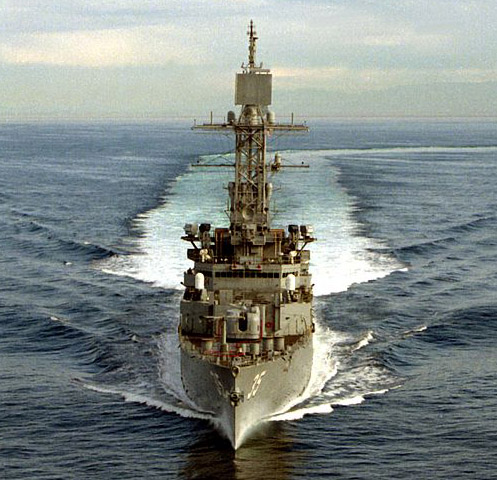
She made her 13th WESTPAC mostly as a Middle East deployment, from 16 August 1991. She performed in the Persian Gulf as AAC, EWC and Force Track Coordinator, but also as Anti-Surface Warfare Commander (ASWC) during Operation Desert Storm. She became Mine Counter-Measure Group 1 flagship on the coastal waters of Kuwait and later escorting Kuwaiti oil tankers as part of “Earnest Will”. She was back at Bremerton, to be dispatched soon in a 2 months Counter-Narcotic deployment off Mexico-Central America until June 1992.
From 12 February 1993 to 1 August 1993 she made her 14th and final WESTPAC via Pearl Harbor, Melbourne (7,180 miles in 11 days at 25 knots, her record). She proceeded to the Indian ocean with USS Nimitz Battle Group and passed the Strait of Hormuz for her previous assignation plus multi-national exercises, notably with the Kuwaiti Air Force. On 22 April she was sent to the Red Sea to enforce a UN blockade and espection of ships bound for Aqaba, boarding 126 merchant vessels. Next she took part in many fleet exercises, for naval gunfire support spotter and Deck Landing Qualification platform, for LAMPS helicopters. She escorted USS Reclaimer towing a defueled nuclear submarine and took part in two more Operations off the coast of San Francisco. By 23 May to 17 June, she became Coalition Forces flagship (CTF 331) for RIMPAC 94.

On 18 August 1994 she was in Bremerton for a final overhaul and left for a final deployment, escorting two defueled nuclear submarines via Panama to Puget Sound. She was detached newt for Task Force 4 in Counter-Narcotic operations. On 3 September she re-transited Panama and back at Bremerton she was decommissioned on 11 September 1995, stricken; disposed of to Ship recycling facility on 16 April 1999.
Read More/Src
Books
Blackman, Raymond V. B. Jane’s Fighting Ships (1970/71)
Polmar, Norman “The U.S. Navy: Shipboard Radars” United States Naval Institute Proceedings December 1978 p.144
Polmar, Norman “The U.S. Navy: Sonars, Part 1” United States Naval Institute Proceedings July 1981 p.119
Doehring, Thoralf. “The TRUXTUN – class”. Unofficial US Navy Site. Retrieved 13 January 2007.
William Blair Johnson GMM3 on USS Truxtun when the conversion took place in the summer of 1979
Toppan, Andrew (17 July 2000). “US Cruisers List: Guided Missile Cruisers”. Haze Gray and Underway.
Hollenbeck, Roger. “The Commodore, USS Truxtun CGN-35 Cruise Book of 1980”. Walsworth Publishing Company, 1980, pp. 1–96.
“U.S. captain silent on question of nuclear warheads”. Press. 28 August 1976 – via Papers Past.
Gibson, G.D. “Westpac I.O. 81–82, The Crew’s Book”. Walsworth Publishing Company, 1982, pp. 1–104.
Links
https://www.nvr.navy.mil/SHIPDETAILS/SHIPSDETAIL_CGN_35.HTML
https://www.navysite.de/cg/cgn35.htm
http://www.truxtunassociation.org/
https://www.navysite.de/cg/cgn35.htm
https://www.navysite.de/cg/cgn35class.htm
https://www.history.navy.mil/research/histories/ship-histories/danfs/t/truxtun-v.html
https://www.secretprojects.co.uk/threads/uss-truxtun.41105/
https://www.navsource.org/archives/04/1135/040135.htm
https://www.globalsecurity.org/military/systems/ship/cgn-35.htm
http://truxtunassociation.org/ships/dlg-cgn35.html
https://en.wikipedia.org/wiki/USS_Truxtun_(CGN-35)
https://www.navypedia.org/ships/usa/us_cr_truxtun.htm
http://www.navsource.org/archives/04/1135/040135.htm
https://commons.wikimedia.org/wiki/Category:USS_Truxtun_(CGN-35)
https://paperspast.natlib.govt.nz/newspapers/CHP19760828.2.7
https://nzhistory.govt.nz/media/sound/uss-truxtun-protest
https://www.seaforces.org/usnships/cgn/CGN-35-USS-Truxtun.htm
https://www.militaryperiscope.com/weapons/sensorselectronics/electronic-support-measureselectronic-warfare/anwlr-1/overview/
https://apps.dtic.mil/sti/pdfs/ADA495417.pdf
https://en.wikipedia.org/wiki/AN/UYK-8
https://en.wikipedia.org/wiki/Naval_Tactical_Data_System

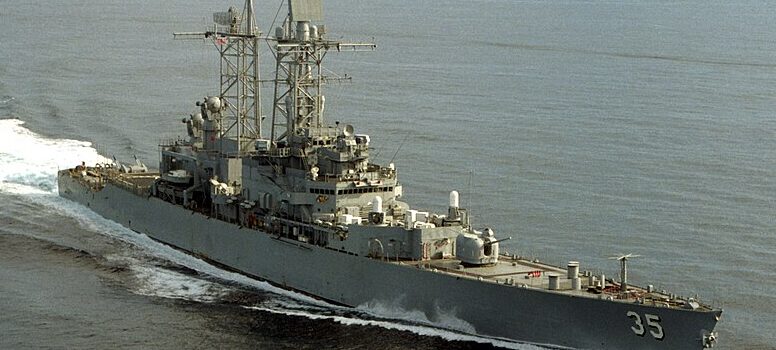
 Latest Facebook Entry -
Latest Facebook Entry -  X(Tweeter) Naval Encyclopedia's deck archive
X(Tweeter) Naval Encyclopedia's deck archive Instagram (@navalencyc)
Instagram (@navalencyc)





 French Navy
French Navy Royal Navy
Royal Navy Russian Navy
Russian Navy Armada Espanola
Armada Espanola Austrian Navy
Austrian Navy K.u.K. Kriegsmarine
K.u.K. Kriegsmarine Dansk Marine
Dansk Marine Nautiko Hellenon
Nautiko Hellenon Koninklije Marine 1870
Koninklije Marine 1870 Marinha do Brasil
Marinha do Brasil Osmanlı Donanması
Osmanlı Donanması Marina Do Peru
Marina Do Peru Marinha do Portugal
Marinha do Portugal Regia Marina 1870
Regia Marina 1870 Nihhon Kaigun 1870
Nihhon Kaigun 1870 Preußische Marine 1870
Preußische Marine 1870 Russkiy Flot 1870
Russkiy Flot 1870 Svenska marinen
Svenska marinen Søværnet
Søværnet Union Navy
Union Navy Confederate Navy
Confederate Navy Armada de Argentina
Armada de Argentina Imperial Chinese Navy
Imperial Chinese Navy Marinha do Portugal
Marinha do Portugal Mexico
Mexico Kaiserliche Marine
Kaiserliche Marine 1898 US Navy
1898 US Navy Sovietskiy Flot
Sovietskiy Flot Royal Canadian Navy
Royal Canadian Navy Royal Australian Navy
Royal Australian Navy RNZN Fleet
RNZN Fleet Chinese Navy 1937
Chinese Navy 1937 Kriegsmarine
Kriegsmarine Chilean Navy
Chilean Navy Danish Navy
Danish Navy Finnish Navy
Finnish Navy Hellenic Navy
Hellenic Navy Polish Navy
Polish Navy Romanian Navy
Romanian Navy Turkish Navy
Turkish Navy Royal Yugoslav Navy
Royal Yugoslav Navy Royal Thai Navy
Royal Thai Navy Minor Navies
Minor Navies Albania
Albania Austria
Austria Belgium
Belgium Columbia
Columbia Costa Rica
Costa Rica Cuba
Cuba Czechoslovakia
Czechoslovakia Dominican Republic
Dominican Republic Haiti
Haiti Hungary
Hungary Honduras
Honduras Estonia
Estonia Iceland
Iceland Eire
Eire Equador
Equador Iran
Iran Iraq
Iraq Latvia
Latvia Liberia
Liberia Lithuania
Lithuania Mandchukuo
Mandchukuo Morocco
Morocco Nicaragua
Nicaragua Persia
Persia San Salvador
San Salvador Sarawak
Sarawak Uruguay
Uruguay Venezuela
Venezuela Zanzibar
Zanzibar Warsaw Pact Navies
Warsaw Pact Navies Bulgaria
Bulgaria Hungary
Hungary

 Bundesmarine
Bundesmarine Dutch Navy
Dutch Navy Hellenic Navy
Hellenic Navy Marina Militare
Marina Militare Yugoslav Navy
Yugoslav Navy Chinese Navy
Chinese Navy Indian Navy
Indian Navy Indonesian Navy
Indonesian Navy JMSDF
JMSDF North Korean Navy
North Korean Navy Pakistani Navy
Pakistani Navy Philippines Navy
Philippines Navy ROKN
ROKN Rep. of Singapore Navy
Rep. of Singapore Navy Taiwanese Navy
Taiwanese Navy IDF Navy
IDF Navy Saudi Navy
Saudi Navy Royal New Zealand Navy
Royal New Zealand Navy Egyptian Navy
Egyptian Navy South African Navy
South African Navy






























 Ukrainian Navy
Ukrainian Navy dbodesign
dbodesign